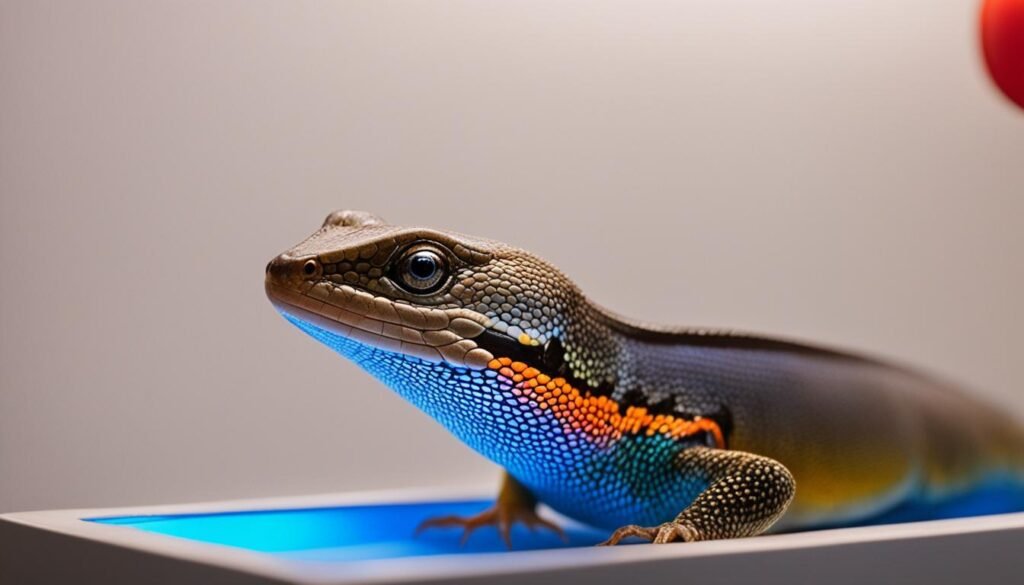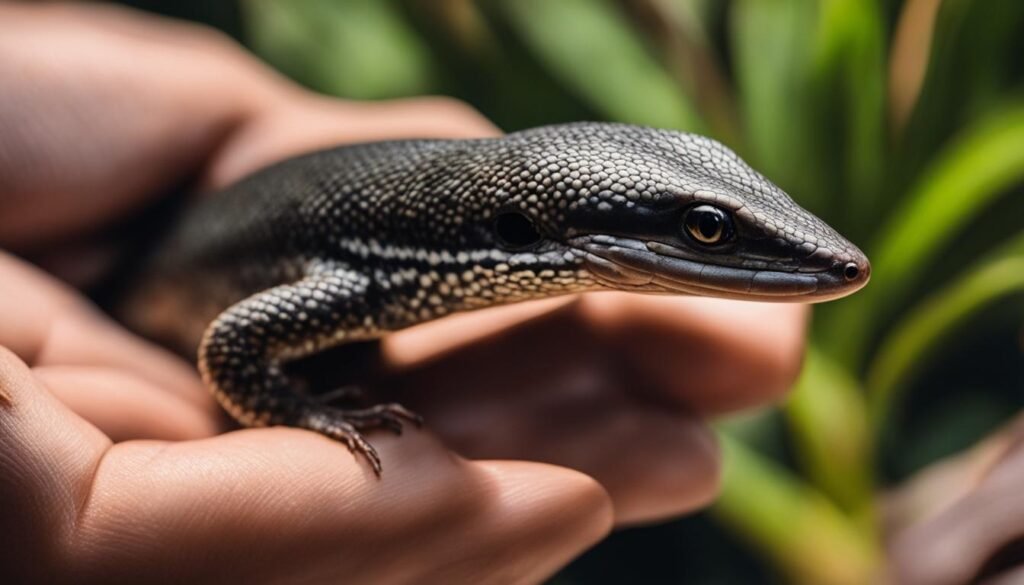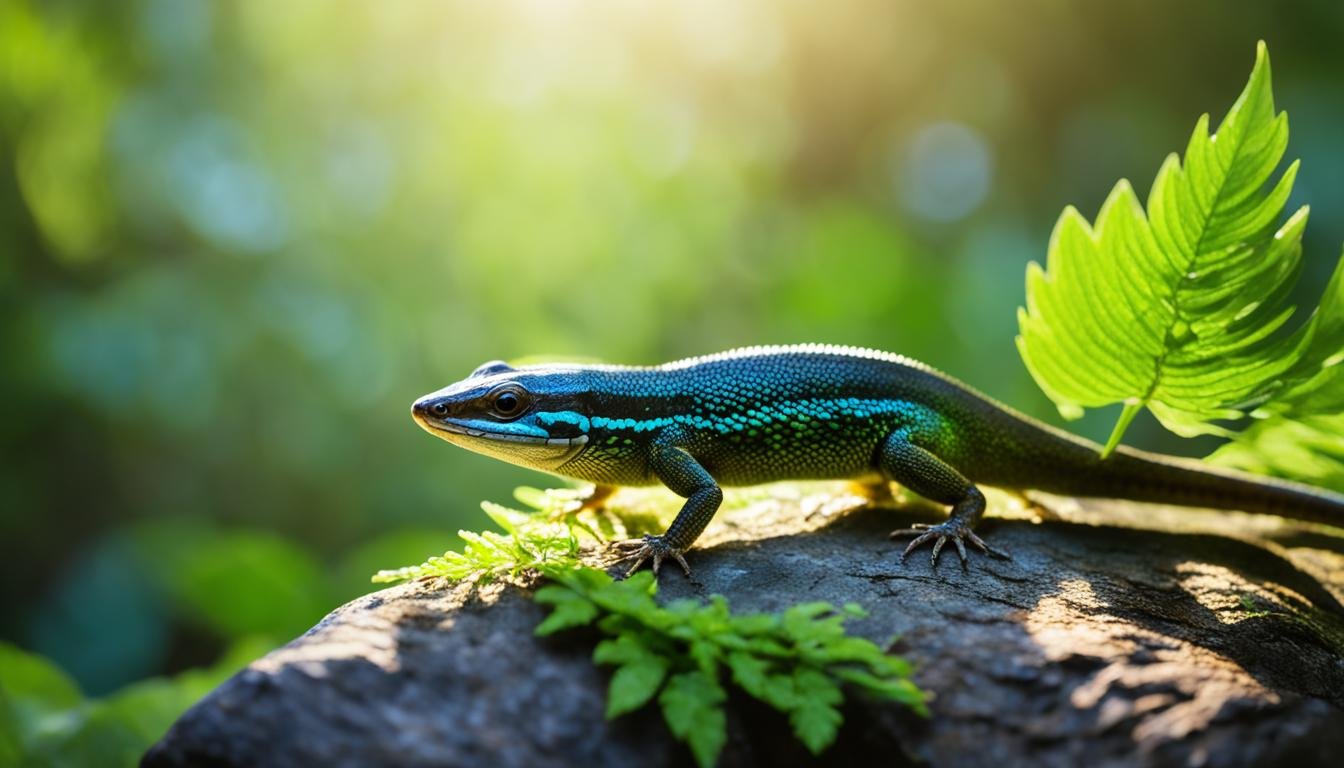Skinks are fascinating reptiles that have captured the hearts of many reptile enthusiasts. With their diverse species, unique behaviors, and relatively low-maintenance care requirements, skinks make great pets for both beginners and experienced reptile owners.
In this essential skink care guide, I will take you through all the important aspects of skink care, including their habitat requirements, diet and feeding, handling and behavior, and how to set up the perfect skink enclosure. Whether you are considering getting a skink as a pet or already have one, this guide will provide you with the knowledge and tips you need to ensure the well-being and happiness of your scaly friend.
Key Takeaways:
- Skinks are popular reptile pets for beginners due to their forgiving care requirements.
- They require a suitable habitat, proper diet, regular handling, and veterinary care.
- Blue-tongued skinks are a popular choice for their friendly temperament.
- Providing a warm, comfortable enclosure with proper lighting and substrate is essential for skink health.
- Regular interaction and handling can help them bond with their owners and become more comfortable with human contact.
Are Skinks Good for Beginners?
Skinks, especially blue-tongued skinks, are considered great pets for beginners. They have low-maintenance care requirements and are easy to handle. Skinks are ideal reptiles for those new to pet ownership, offering a rewarding and relatively hassle-free experience.
As a beginner-friendly reptile, skinks require minimal special care compared to other reptile species. They are hardy and adaptable, making them easier to care for. This means you can focus on enjoying your pet rather than constantly tending to complex care needs.
One of the advantages of owning a skink as a beginner is their ease of handling. Skinks, especially blue-tongued skinks, are known for their docile nature and tolerance of human interaction. This makes them suitable for both children and adults, providing an opportunity for a positive and educational pet ownership experience.
Whether you are a reptile enthusiast looking to expand your collection or a first-time pet owner, skinks are excellent companions. Their low-maintenance care requirements and friendly temperament make them an ideal choice for beginners seeking a reptile pet that is both fascinating and enjoyable to care for.
Skink Habitat Requirements
Creating a suitable habitat is crucial for the well-being and thriving of skinks. The right enclosure, temperature, humidity, lighting, substrate, and decor are essential factors to consider.
Enclosure Size
Skinks need an appropriately sized enclosure to provide room for exploration and activities. Consider the size of the skink species you have and provide ample space for them to move around comfortably.
Temperature
Maintaining the correct temperature in the skink enclosure is vital for their overall health and well-being. Skinks are ectothermic, meaning they rely on external heat sources to regulate their body temperature. Provide a temperature gradient within the enclosure, ranging from 75°F (24°C) on the cooler side to 90°F (32°C) on the warmer basking area. Using a temperature-controlled heating system, such as heat mats or basking lamps, can help achieve and maintain the desired temperature levels.
Humidity
Adequate humidity levels are essential for skinks as they require a certain level of moisture to thrive. The ideal humidity range varies between skink species, but generally, a humidity level of 40%-60% is recommended. You can maintain the humidity by misting the enclosure daily and providing a suitable humid hide where the skink can retreat to boost humidity levels when needed.
Lighting
Skinks require UVB lighting to assist with vitamin D3 synthesis and calcium absorption, essential for their overall health and proper growth. It’s important to provide a UVB light source specifically designed for reptiles. Position the UVB light within the enclosure according to the manufacturer’s instructions to ensure the skink receives proper exposure and ultraviolet radiation.
Substrate
Choosing the right substrate is vital for maintaining proper hygiene, facilitating natural behaviors, and ensuring the skink’s safety. Suitable substrate options include aspen or cypress mulch, coconut husk, or reptile carpet. Avoid using substrates that can cause impaction or respiratory issues, such as sand or small loose particles.
Hiding Spots and Climbing Decor
Skinks require hiding spots and climbing opportunities within their enclosure to feel secure and express their natural behaviors. Incorporate various types of hiding spots, such as reptile caves, bark pieces, or commercial reptile shelters. Provide branches, logs, or rocks for climbing and basking areas, allowing the skinks to engage in their natural instincts and thermoregulation.
Creating an ideal habitat for your skinks will significantly contribute to their overall well-being and happiness. It’s important to continuously monitor and fine-tune the habitat conditions based on the specific needs of your skink species to ensure they thrive in their environment.
Skink Diet and Feeding
Providing a balanced diet is crucial for the health and well-being of your skink. As omnivorous reptiles, skinks require a combination of protein-rich insects and nutrient-packed vegetables in their diet. A varied feeding regimen is key to meeting their dietary needs.
Protein Sources
Skinks thrive on a diet that includes a variety of insects. Some commonly offered insects for skinks include crickets, mealworms, and dubia roaches. These insects not only provide the necessary protein but also offer enrichment and mental stimulation during feeding time.
Vegetables and Greens
In addition to insects, skinks also benefit from a selection of vegetables and greens. These plant-based foods provide essential vitamins, minerals, and fiber. Some suitable options include leafy greens like collard greens, dandelion greens, and kale. Root vegetables like sweet potatoes and carrots can also be offered.
A Balanced Approach
To ensure a well-rounded diet, it’s important to offer a mix of insects and vegetables. Aim for a ratio of approximately 60% insects to 40% vegetables. This balance mimics the skink’s natural omnivorous diet and provides them with all the necessary nutrients for optimal health.
| Protein Sources | Vegetables and Greens |
|---|---|
| Crickets | Collard greens |
| Mealworms | Dandelion greens |
| Dubia roaches | Kale |
| Sweet potatoes | |
| Carrots |
Keep in mind that skinks may have individual preferences when it comes to their diet. It’s important to experiment with different foods and observe how your skink responds. Offer a variety of options, alternating between different insects and vegetables, to prevent monotony and ensure nutritional diversity.
Remember to dust the insects with a calcium supplement before feeding them to your skink. This helps maintain proper calcium levels, which are essential for healthy bone and shell development.
Skink Handling and Behavior
Skinks are generally friendly reptiles that can tolerate handling. Regular interaction and handling can help them become more comfortable with human contact. However, it’s important to handle them gently and give them time to adjust to new situations.
Skink Behavior
Skinks exhibit a range of behaviors that can vary depending on their species and individual personalities. Understanding their behavior can help you provide the appropriate care and interaction. Here are some common behaviors observed in skinks:
- Basking: Skinks love to bask under their heat source to regulate their body temperature.
- Digging: Many skinks are natural burrowers and enjoy digging in their substrate.
- Exploring: Skinks are curious creatures and enjoy exploring their environment.
- Tail wagging: Some skinks may wag their tails as a defensive behavior or to communicate with others.
Skink Handling
Skinks can be handled, but it’s important to approach them with care and respect for their comfort and safety. Here are some tips for handling skinks:
- Wash your hands before handling a skink to minimize the transfer of oils and bacteria.
- Approach the skink calmly and avoid sudden movements to prevent startling them.
- Support their body properly by gently scooping them up, ensuring you have a secure grip.
- Avoid grasping their tail, as they can drop it as a defense mechanism.
- Start with short handling sessions and gradually increase the duration as they become more comfortable.
- Monitor their behavior while handling and watch for signs of stress, such as hissing or trying to escape.
| Skink Handling Dos | Skink Handling Don’ts |
|---|---|
| Handle the skink gently and with care | Grasp or pull their tail |
| Support their body to prevent injury | Handle them when they are shedding |
| Wash your hands before and after handling | Handle them when they are stressed or aggressive |
| Start with short handling sessions and gradually increase duration | Force them to interact if they show signs of discomfort |
Remember, each skink is unique, and some individuals may have different reactions to handling. If you notice any signs of stress or aggression, give them time and space to relax. Building a positive and trusting relationship with your skink through gentle handling and interaction will contribute to a rewarding experience as a skink owner.
Skink Enclosure Setup
Setting up a proper and comfortable enclosure is essential for the well-being of your skink. A well-designed skink enclosure should provide appropriate heating, lighting, and decorations to meet their needs.
To create the ideal environment for your skink, consider the following:
Heating
Skinks require a temperature gradient within their enclosure to regulate their body temperature effectively. Provide a warm basking area with a temperature range of 90-95°F (32-35°C) to mimic their natural habitat. Use a basking lamp or heat mat to maintain the desired temperature. On the cooler side of the enclosure, maintain a temperature range of 75-85°F (24-29°C) to allow for thermoregulation.
Lighting
Skinks need access to UVB lighting to synthesize vitamin D3 and maintain proper calcium metabolism. Install a full-spectrum UVB bulb in the enclosure, preferably with an output of 5-10%, to provide the necessary UVB radiation. Ensure the bulb is positioned at an appropriate distance to ensure optimal exposure.
Decorations
Incorporating suitable decorations and furnishings in your skink’s enclosure is important to stimulate natural behavior and provide enrichment. Rocks, logs, and branches offer opportunities for climbing, while hides and tunnels provide essential hiding spots for security. Use non-toxic materials and avoid sharp edges or small parts that may cause injury.
Here is an example of a well-designed skink enclosure:
| Heating | Lighting | Decorations |
|---|---|---|
| Warm basking area with a temperature of 90-95°F (32-35°C) | Full-spectrum UVB bulb with an output of 5-10% | Rocks, logs, branches for climbing |
| Cooler side with a temperature of 75-85°F (24-29°C) | Properly positioned UVB bulb for optimal exposure | Hides and tunnels for hiding and security |
By providing the right heating, lighting, and decorations, you can create a comfortable and stimulating environment for your skink, allowing them to thrive and display their natural behaviors.
Skink Health and Lifespan

Skinks are generally healthy reptiles with a lifespan of 15-20 years or longer. Regular maintenance, such as proper diet, hygiene, and veterinary care, is essential for their well-being. While skinks are generally resilient, they can still be susceptible to certain diseases and health issues that can impact their lifespan and overall health. It is important for skink owners to be knowledgeable about common diseases and take preventive measures to ensure the well-being of their pet.
Common Skink Diseases
Skinks can be prone to various diseases, some of which include:
- Respiratory infections
- Parasitic infestations
- Gastrointestinal disorders
- Skin infections
- Mouth rot
It is crucial to monitor your skink’s behavior and appearance for any signs of illness, such as loss of appetite, lethargy, abnormal bowel movements, skin lesions, or discharge. If you notice any concerning symptoms, it is recommended to consult a veterinarian who specializes in reptile care.
Maintenance for Skink Health
To ensure the good health of your skink, here are some important maintenance practices:
- Provide a balanced diet: Skinks require a diet that consists of a mix of insects, vegetables, and greens. This provides them with essential nutrients and helps prevent deficiencies.
- Maintain a clean enclosure: Regularly clean and disinfect your skink’s enclosure to minimize the risk of bacterial or fungal infections. Remove feces, uneaten food, and any damp or soiled substrate.
- Monitor temperature and humidity levels: Skinks need specific temperature and humidity ranges to thrive. Use a thermometer and hygrometer to ensure these parameters are within the recommended range for your skink species.
- Handle with care: When handling your skink, always wash your hands before and after to minimize the risk of spreading germs. Avoid rough handling and sudden movements that may cause stress or injury.
- Schedule regular veterinary check-ups: Skinks should have routine check-ups with a reptile veterinarian to detect any underlying health issues early on and receive appropriate treatment.
By practicing good skink health maintenance and staying vigilant for any signs of illness, you can help ensure a long and healthy lifespan for your beloved reptilian companion.
Skink Care Tips for Beginners
As a beginner in reptile care, it’s essential to understand the specific needs of skinks to ensure their health and well-being. Here are some valuable tips to help you provide the best care for your skink:
Create a Suitable Habitat
Skinks require a well-designed enclosure that mimics their natural habitat. Ensure the temperature, humidity, and lighting within the enclosure are appropriate for your skink species. Provide hiding spots, climbing decor, and a suitable substrate to create a comfortable environment.
Feed a Balanced Diet
Skinks are omnivorous reptiles, meaning they eat a combination of insects and plant-based foods. Offer a balanced diet that includes a variety of insects, such as crickets and mealworms, along with vegetables and greens. Consult a reptile veterinarian or a knowledgeable resource to determine the best diet for your skink species.
Handle Skinks Gently
Skinks can become accustomed to human handling with proper care and regular interaction. However, it’s important to handle them gently and give them time to adjust to their new environment. Avoid excessive handling during the first few weeks to allow your skink to settle in comfortably.
Monitor the Enclosure Conditions
Regularly check and maintain the temperature, humidity, and lighting within the skink enclosure. Use thermometers, hygrometers, and light timers to ensure consistent and appropriate conditions. Regularly clean the enclosure, remove any waste, and provide fresh water for drinking and soaking.
Observe Skink’s Behavior and Health
Take the time to observe your skink’s behavior and appearance regularly. Look out for any signs of illness or distress, such as changes in appetite, skin problems, or lethargy. If you notice any concerning symptoms, consult a reptile veterinarian for proper diagnosis and treatment.
Provide Environmental Enrichment
Skinks benefit from environmental enrichment to stay mentally and physically stimulated. Consider adding natural decor, such as branches and rocks, for climbing and exploring. Provide appropriate toys and activities to encourage natural behaviors and keep your skink engaged.
Consult Reptile Experts
Always seek guidance from reptile experts, such as experienced reptile keepers or reputable reptile forums or communities. Joining these communities can provide valuable insights, tips, and advice specific to skink care.
| Skink Care Tips for Beginners |
|---|
| 1. Create a suitable habitat |
| 2. Feed a balanced diet |
| 3. Handle skinks gently |
| 4. Monitor the enclosure conditions |
| 5. Observe skink’s behavior and health |
| 6. Provide environmental enrichment |
| 7. Consult reptile experts |
Skink Bonding with Owners

Skinks are not only fascinating reptiles but also capable of forming strong bonds with their owners through regular interaction and handling. Building a bond with your skink can be a rewarding experience that enhances your relationship and creates a sense of trust.
When it comes to bonding with your skink, consistent and positive interaction is key. Spend quality time with your skink in its enclosure, talking to it and offering treats as rewards. This helps establish a connection and builds trust between you and your pet.
Patience is crucial during the bonding process. Skinks may require some time to acclimate to their new environment and new human companions. It’s essential to approach them gently and respect their boundaries, allowing them to adjust at their own pace.
Positive reinforcement is an effective tool for fostering a strong bond with your skink. When your skink displays desired behaviors, such as willingly approaching you or showing curiosity during handling, provide praise and rewards. This encourages them to feel more comfortable and secure during interactions.
Skink Bonding Tips:
- Spend regular, dedicated time with your skink to establish a routine and develop familiarity.
- Talk to your skink in a gentle and soothing voice to create a calming presence.
- Offer treats as rewards for positive behavior to reinforce trust and build a positive association.
- Handle your skink gently and with confidence, allowing it to explore and interact at its own pace.
- Be consistent in your interactions to establish a predictable and comfortable environment for your skink.
Bonding with your skink takes time and effort, but the rewards are well worth it. As the bond between you and your skink grows stronger, you’ll be able to enjoy a deeper level of interaction and companionship.
| Benefits of Skink Bonding | Ways to Strengthen the Bond |
|---|---|
|
|
Skink Species and Varieties
When it comes to skinks, there is a wide variety of species to choose from. One of the most popular options among reptile enthusiasts is the blue-tongued skink. With its striking blue tongue and docile temperament, it has captured the hearts of many pet owners. However, it’s important to note that there are other skink species available, each with its own unique characteristics and care requirements.
Before deciding on a skink species, research is crucial to ensure you provide the right environment and care. Consider factors such as size, habitat preferences, and activity levels when selecting a skink that suits your preferences and expertise.
Here are some common skink species that you might come across:
- Blue-tongued Skink
- Fire Skink
- Red-eyed Crocodile Skink
- Mourning Gecko
- Emerald Tree Skink
Each of these species has its own unique set of characteristics, making them fascinating in their own right. Some may require specific temperature and humidity levels, while others have different dietary needs. Understanding the requirements of your chosen skink species is vital to their health and well-being.
Remember, always consult with a reputable breeder or herpetologist to ensure you have accurate information and guidance when caring for a specific skink species.
Skink Species Comparison
| Species | Size | Preferred Habitat | Diet |
|---|---|---|---|
| Blue-tongued Skink | Medium to large | Forest, woodlands | Omnivorous – insects, fruits, vegetables |
| Fire Skink | Medium | Tropical rainforest | Insects, small invertebrates |
| Red-eyed Crocodile Skink | Small | Rainforest floor | Insects, fruit, small vertebrates |
| Mourning Gecko | Small | Tropical rainforest, coastal areas | Insects and small invertebrates |
| Emerald Tree Skink | Medium | Forest canopy | Insects, fruits, nectar |
Conclusion
Skinks are fascinating reptiles that make excellent pets for reptile enthusiasts of all experience levels. By following a skink care guide, providing proper reptile care, and prioritizing responsible pet ownership, you can ensure that your skinks live a long and healthy life.
Proper care for skinks includes creating a suitable habitat with the correct temperature, humidity, and lighting conditions. Investing in a proper skink enclosure setup, complete with appropriate heating and lighting devices, is crucial. Additionally, providing hiding spots and climbing decorations will contribute to their overall well-being.
Feeding your skinks a balanced diet of insects and vegetables is essential for their health. Regular interaction and gentle handling can help them become more comfortable with human contact, resulting in a stronger bond between you and your pet. Monitoring their health and promptly seeking veterinary care when needed will ensure a fulfilling and rewarding experience as a skink owner.
FAQ
Are skinks good pets for beginners?
What are the habitat requirements for skinks?
What should I feed my skink?
How should I handle my skink?
How do I set up a skink enclosure?
How long do skinks live and how can I maintain their health?
What are some care tips for beginners who own skinks?
How can I bond with my skink?
What are the different species and varieties of skinks?
References
| Organization Name | URL |
|---|---|
| International Reptile Conservation Foundation (IRCF) | https://www.ircf.org/ |
| Herpetological Conservation International | https://herpconservation.com/index.html |
| Society for the Study of Amphibians and Reptiles (SSAR) | https://ssarherps.org/about-ssar/ |
Please check out other articles like Facts About Turtles: Eunotosaurus And Turtle Evolution


10 thoughts on “Essential Skink Care Guide for Reptile Enthusiasts”